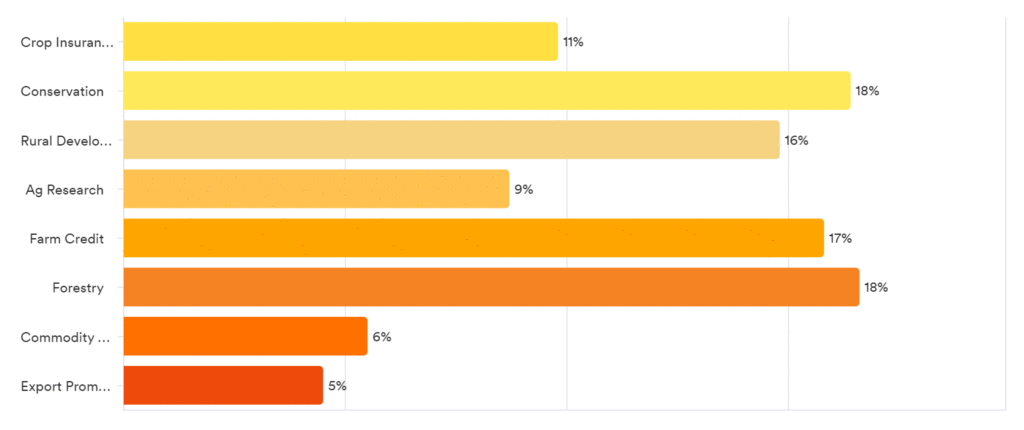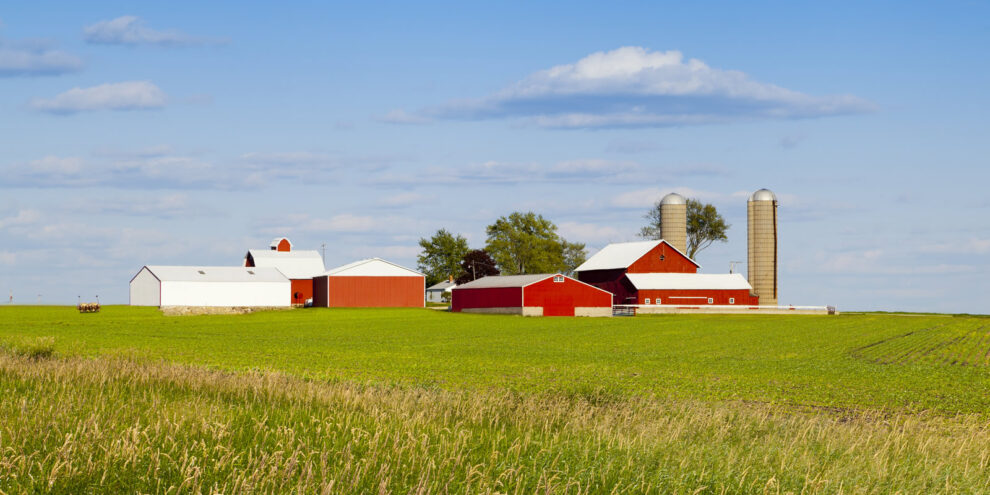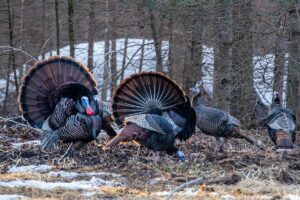According to the September LANDTHINK Pulse results, Conservation and Forestry are the two top priorities for funding in the Farm Bill debate. It was a tie between these two titles, with 18% of our respondents indicating Conservation and 18% indicating Forestry as two areas that should be prioritized. The Farm Bill is a multiyear package of legislation that oversees a variety of domestic and international food and agricultural programs. Passage of the 2023 Farm Bill, which was expected to occur prior to Sept. 30, when the 2018 Farm Bill expired, has been delayed. Work is at a standstill on this year’s Farm Bill, and lawmakers now face a much stricter end-of-year deadline.
Last month, the September Pulse asked: Of the following Farm Bill negotiations up for renewal, which 3 are most important to you?

The Farm Bill is a massive comprehensive piece of legislation and controls how billions of taxpayer dollars are distributed. The bill covers everything from farm programs, conservation, rural development, forestry, trade promotion, nutrition, and even ag research and education. In addition, the bill also governs social programs such as the Supplemental Nutrition Assistance Program, or SNAP. The Farm Bill’s provisions are divided into “titles,” 12 as of 2018, which cover various aspects of agriculture.
Congress passes a new Farm Bill every five years and the 2023 Farm Bill is expected to be the most expensive ever. For the first time, the Farm Bill is projected to cost more than $1 trillion, roughly $140 billion each fiscal year. The SNAP program accounts for 80 percent of the budget.
Title II: Conservation
The Conservation section of the Farm Bill covers several important programs, some of which have been used for decades, to assist farmers in implementing sustainable practices. Conservation efforts made up 7% of the 2018 bill – $60 billion out of an estimated $867 billion over 10 years, according to the Congressional Research Service.
The conservation title is all about resource conservation, promoting sustainable farming practices and protecting local ecosystems. Many of the programs in this section provide water quality improvement and help mitigate climate change.
The Farm Bill has included stand-alone farm conservation programs since 1985. Today, the big three account for 7% of the spending.
The Conservation Reserve Program (CRP) provides financial incentives for private landowners to remove large swaths of land from agricultural production. The program provides a yearly rental payment to private landowners who remove environmentally sensitive land from agricultural production for 10 to 15 years and plant species that will improve environmental health and quality. The landowner enters into an agreement with the government and the annual payment is fixed at the time of the contract. CRP was introduced as part of the 1985 Farm Bill. This voluntary long-term cropland retirement program is the longest-running conservation program in the Farm Bill. The Conservation Reserve Program is one of the most popular programs among farmers, with more than 5 million acres enrolled in 2023.
The Environmental Quality Incentives Program (EQIP), with the help of technical experts from the U.S. Department of Agriculture, provides free help to farmers interested in incorporating conservation practices into their ranching and crop production. Mandatory EQIP funding first set out in the 2018 Farm Bill increased from $1.75 billion in fiscal year 2019 to $2.025 billion by fiscal year 2023. However, the Inflation Reduction Act, which passed in August 2022, included an additional $18.05 billion for working lands programs, bringing EQIP’s total appropriation to $8.45 billion through 2026. The most recent data available from the Natural Resources Conservation Service (NRCS) indicates there were 33,701 active and completed EQIP contracts across 10.5 million acres in the U.S. in 2020.
The Conservation Stewardship Program (CSP), which also provides one-on-one technical assistance, as well as annual payments to encourage agricultural producers to meet conservation goals over five year contracts. In CSP, participants must meet a “stewardship threshold” for a set number of priority resource concerns when they apply for the program and must agree to meet or exceed the stewardship threshold for additional priority resource concerns by the end of the contract. Contracts last up to 10 years and enrollment in the program is offered through a continuous sign-up period. NRCS data indicates there were 4,922 active CSP contracts across more than 6.4 million acres in the U.S. in 2020.
Title VIII: Forestry
There’s about 765 million acres of forestland in the United States – and any programs to conserve or restore it fall under this title. A forestry-driven program might fund restoration of damaged forest landscapes, protect watersheds, save endangered species and more. It also funds the United States Forest Service. Added to the farm bill in 2002, the forestry title authorizes the U.S. Forest Service to manage federal forest land. The forestry title is a small part of the Farm Bill, but other forestry programs appear in other titles, especially conservation. Forestry programs are subject to appropriations. On July 27, the Forest Conservation Easement Program (FCEP) Act of 2023 was introduced in the U.S. Senate to advance private forest conservation that will complement other successful Farm Bill Title II programs.
According to the Forest Society, the Forest Conservation Easement Program is designed to:
- Significantly improve and enhance the ability of the NRCS to effectively conserve working forests at scale through conservation easements.
- Prioritize keeping forests as forests continuing to provide a multitude of environmental, economic, and societal benefits.
- Help landowners restore, enhance, and protect habitat for at-risk species while increasing carbon sequestration.
- Provide landowners with two proven options for placing voluntary conservation easements on their land, with one held by the federal government and one held by eligible entities and land trusts.
The 2018 Farm Bill expired on Sept. 30, 2023, as government officials focused on passing a 45-day continuation of the federal budget. The House and Senate Agriculture committee leaders have set Dec. 31 as the new deadline for a final bill. They say an extension isn’t necessary if they can finish before Jan. 1, 2024, when 1940s farm policies of supply management and higher dairy and crop subsidies would start to take effect.
The LANDTHINK audience indicated that they prioritize many of the main components of the 2023 Farm Bill. It was a mixed bag of results, but the largest percentage (18%) identified Conservation and Forestry as top priority, followed closely by 17% of our audience, who said Farm Credit. A strong percentage (16%) said that Rural Development should be prioritized. Only (11%) of respondents said Crop Insurance, 9% Ag Research, 6% said Commodity Programs and just 5% said Export Promotion.
Do you have a suggestion for next month’s Pulse question? Submit your question and we might choose yours!
This content may not be used or reproduced in any manner whatsoever, in part or in whole, without written permission of LANDTHINK. Use of this content without permission is a violation of federal copyright law. The articles, posts, comments, opinions and information provided by LANDTHINK are for informational and research purposes only and DOES NOT substitute or coincide with the advice of an attorney, accountant, real estate broker or any other licensed real estate professional. LANDTHINK strongly advises visitors and readers to seek their own professional guidance and advice related to buying, investing in or selling real estate.










Add Comment